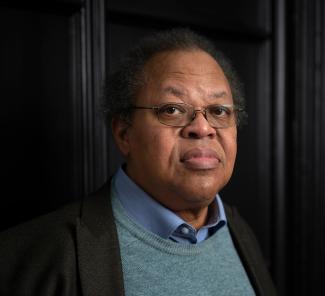Event
New Music and the Heterogenous Sound Ideal
Colloquium Lecture by George Lewis
George Lewis
New Music and the Heterogenous Sound Ideal
December 12, 2023 (Tuesday) — 5:15 pm to 7:00 pm
Lerner Center
Penn Music Building
201 S. 34th Street, Room 101
ABSTRACT
The writings of African American composer Olly Wilson (1937-2018) exercised enormous influence in proposing an African-American musical aesthetic in contemporary classical music. Wilson portrays Afrodiasporic music-making as exhibiting “shared conceptual approaches,” which he eventually subsumes under his notion of the “heterogeneous sound ideal…a fundamental bias for heterogeneity of sound rather than similarity of color or homogeneity.”
An influential 1991 essay by art historian Robert L. Douglas, while not referencing Wilson’s work, proposes something quite similar in the visual arts, with his notion of “multidominant elements,” or “the multiple use of colors in intense degrees, or the multiple use of textures, design patterns, or shapes.” For Douglas, multidominance is well described with reference to multiple meters in traditional African music, but he uses the concept to contextualize the work of the Africobra artists who began their work in the late 1960s, including Jeff Donaldson, Wadsworth Jarrell, Jae Jarrell, and Barbara Jones-Hogu. Moreover, both Wilson and Douglas may be placed in intersection with art historian Robert Farris Thompson, who saw the black Atlantic visual tradition—for example, Akan asadua cloth, woven using narrow, multistrip patterns--as displaying “a propensity for multiple meter.”
Wilson presents numerous examples of the heterogeneous sound ideal in a wide range of African and African American musical practices, with the curious exception of contemporary music—his own primary field. His 1970 orchestra work Voices, however, exemplifies many of the tendencies he identifies; its swirling, repetitive sonic behaviors and uncanny effects are only one part of the work’s overall heterogeneity of sound and color. The main direction in this talk, then, is taken directly from Wilson’s piece. Through examples from the work of a diverse (and by no means exhaustive) range of Afrodiasporic contemporary composers, I want to identify aesthetic directions that appear frequently in Afrodiasporic contemporary classical music since 1960, connecting these with larger issues in the creolization of the field as a whole.
BIO
George Lewis is an American composer, musicologist, computer-installation artist, and trombonist. He is Case Professor of American Music at Columbia University, and Area Chair in Composition, and Artistic Director of the International Contemporary Ensemble. A Fellow of the American Academy of Arts and Sciences and the American Academy of Arts and Letters, a Corresponding Fellow of the British Academy, and a member of the Akademie der Künste Berlin, Lewis’s other honors include the Doris Duke Artist Award (2019), a MacArthur Fellowship (2002), and a Guggenheim Fellowship (2015). A member of the Association for the Advancement of Creative Musicians (AACM) since 1971, Lewis's work is presented by ensembles worldwide, published by Edition Peters. A Yamaha Artist, Lewis is widely regarded as a pioneer in the creation of computer programs that improvise in concert with human musicians.
Lewis’s central areas of scholarship are exemplified by his widely read book, A Power Stronger Than Itself: The AACM and American Experimental Music (University of Chicago Press, 2008) which received the American Book Award and the American Musicological Society’s Music in American Culture Award. Lewis is the co-editor (with Harald Kisiedu) of the bilingual edited volume Composing While Black: Afrodiasporic New Music Today/Afrodiasporische Neue Musik Heute (2023), and (with Benjamin Piekut) the two-volume Oxford Handbook of Critical Improvisation Studies (2016). He holds honorary doctorates from the University of Edinburgh, Harvard University, the University of Pennsylvania, Oberlin College, School of the Art Institute of Chicago, New England Conservatory, New College Of Florida, and Birmingham City University, among others.
ATTENDANCE & REGISTRATION
This event is free and open to the public. If you attend in person, there is no need to register. We ask that you join us in person if at all possible, but for those of you who are unable to physically attend we encourage you to participate via Zoom. Please return in this fall for a registration link to attend virtually.
ABOUT
This lecture is part of the 2023-24 Penn Music Colloquium Series. The Department of Music's main Colloquium Series showcases new research by leading scholars in music and sound studies and composers both in the United States and internationally. All Music Colloquia will take place in Room 101 of the Lerner Center on Tuesdays at 5:15 PM.
